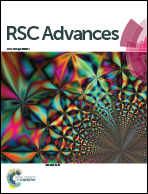Preparation and characterization of a dual-receptor mesoporous silica nanoparticle–hyaluronic acid–RGD peptide targeting drug delivery system
Abstract
A dual-receptor targeting delivery system based on mesoporous silica nanoparticles modified with hyaluronic acid and RGD peptide (MSNs/NH2–HA–RGD) was developed in the present study, and characterized by TEM, SAXRD, nitrogen adsorption–desorption analysis, DLS, FT-IR, 13C NMR and UV-vis. The results showed that MSNs/NH2–HA–RGD had an ideal monodispersibility, uniform particle size (172.5 ± 10 nm) and well-defined mesoporous structure. Moreover, cellular uptake results showed that MSNs/NH2–HA–RGD had an ideal dual-receptor mediated endocytosis pathway and could be significantly internalized into ovarian cancer cells. Chlorambucil (CHL), an anticancer drug, was chosen as a model drug to investigate drug loading, in vitro drug release behaviors and cytotoxicity. The results showed that CHL-loaded MSNs/NH2–HA–RGD exhibited a high drug loading capacity of about 10.1% and pH-sensitive drug controlled release behaviors. The cytotoxicity test showed that CHL-loaded MSNs/NH2–HA–RGD had a stronger cytotoxicity for ovarian cancer cells than one receptor or no receptor modified MSNs. It is expected that MSNs/NH2–HA–RGD may be a prospective candidate for targeted delivery of anticancer drugs to cancer foci.


 Please wait while we load your content...
Please wait while we load your content...